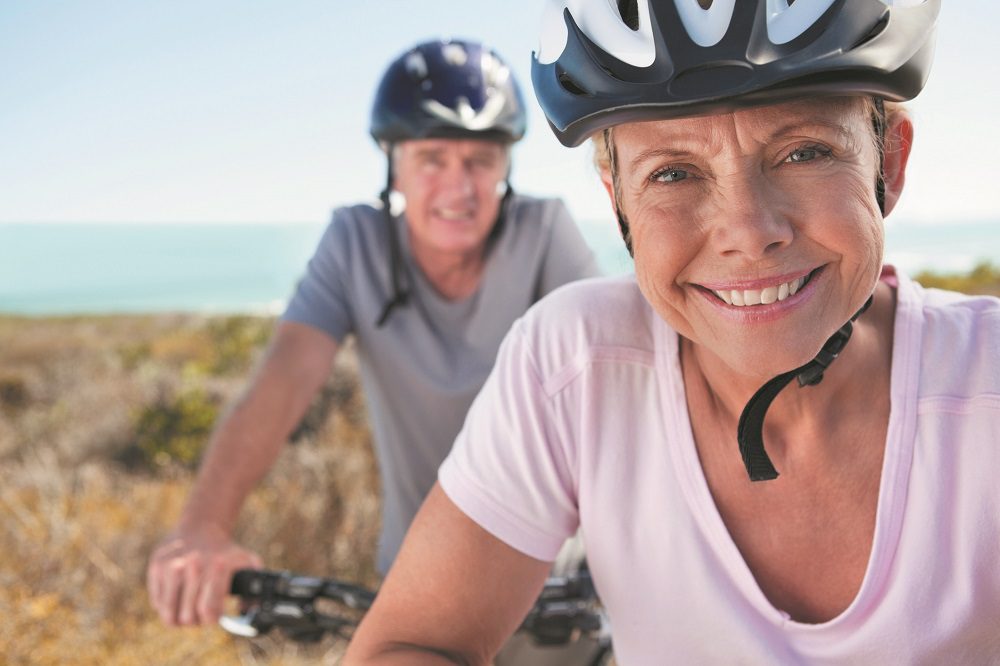Now that summer is here, millions of Americans are out jogging, running, hiking, and biking. But summer exercise comes with some risks. Here’s how to maintain your healthy habits while keeping yourself safe.
Dehydration
Working up a sweat is great for health, but rising temperatures can set you up for dehydration. Older adults are especially prone because, as we age, we have a diminished ability to regulate temperature, recognize thirst, and store water. (The last has to do with age-related loss of muscle mass, as muscle helps hold on to water.) Older adults are also more likely to take medications that increase dehydration risk, like diuretics (for high blood pressure and heart failure) and antacids. Dehydration can cause dizziness, muscle cramps, balance issues, and can even land you in the hospital.
Stay safe: Most people assume that feeling thirsty is the first sign that they need to start hydrating, but by the time you feel thirsty, you’re already on your way to becoming dehydrated.
Prepare for outdoor exercise by pre-hydrating: increasing water intake for one or two days before the workout. This gives your body the chance to fully soak up all that hydration.
While exercising, sip water every 15 minutes. Plain water works well, or try electrolyte-enhanced water. Electrolytes are minerals (usually sodium, potassium, or magnesium) that help regulate hydration, blood pressure, and muscle contraction. Unsweetened coconut water is naturally rich in electrolytes and lower in sugar than many commercial sports drinks, so it may be a better choice, especially for people with diabetes.
If your urine is dark yellow or amber, it’s an indicator you need more water. Pale yellow is ideal.
Overheating
When your body is too hot for an extended period of time, it can overheat, just like your car. Peoples ages 65 and older are more likely to experience heat-related health complications than the general population, potentially even requiring hospitalization. Overheating, also called hyperthermia, can lead to several dangerous conditions:
- Heat syncope can cause dizziness or fainting. (If you take beta-blockers, you are especially susceptible to this condition.)
- Heat exhaustion can manifest as weakness, dizziness, thirst, nausea, poor coordination, excessive sweating, rapid hear trate, or clammy skin.
- Heat stroke is an emergency requiring immediate medical care. Signs include loss of consciousness; confusion, aggressiveness, or otherwise odd behavior; weak pulse; and not sweating despite extreme heat.
Stay safe: If possible, avoid exercising outdoors between 10 a.m. and 3 p.m., the hottest parts of the day. Check the heat index, a measure of how hot it feels once humidity is factored in, before heading out. (Humidity intensifies heat and prevents sweat from evaporating, hampering the body’s natural cooling mechanism.) Exercise indoors if the heat index surpasses 90. Stay hydrated and wear light-colored, sweat-wicking materials and a hat that also covers the back of your neck. (Lighter colors absorb less heat.) If you feel faint, rest in a cool, ideally air-conditioned, area, with your legs elevated above your heart, and hydrate.
Falling
Hiking is a wonderfully healthy activity for both body and mind, but it comes with the risks of tripping over rocks or branches, losing your footing while climbing up or down hills, and falling. Heavy backpacks can compromise balance. Nearly half of all mountain hiking accidents are caused by falls.
Falls happen on paved surfaces, too. In fact, many of my patients between ages 50 and 65 have fallen when walking on sidewalks or stepping off of curbs, usually because they were using their phone or otherwise not paying attention. This sort of distracted walking also changes your gait and speed.
Stay safe: Pay attention to your surroundings while hiking, running, speed-walking, or engaging in your favorite outdoor activity. Scan the ground for trip hazards, such as rocks, twigs, and holes. Avoid multitasking (such as texting while walking, jogging, or biking). If you are wearing a backpack, make sure there’s not too much weight in the top half, which can throw you off-kilter.
Nordic-style walking poles, also called trekking poles, offer an additional layer of insurance. Held like ski poles, they improve balance and stability while also working the upper body, which doesn’t normally happen while hiking or walking. Look for ones with removable rubber tips that can be used on paved surfaces and then removed for hiking. Poles can be especially helpful for arthritis sufferers, offsetting the pressure on hips and knees. YMCAs often offer pole-walking classes.
Wear appropriate footwear, such as hiking sneakers or boots that provide traction and ankle support. Also, remember to pace yourself. When we’re fatigued, we tend to not properly pick up our feet, which can lead to stumbles.


